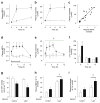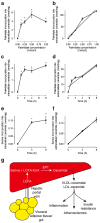Regulation of plasma ceramide levels with fatty acid oversupply: evidence that the liver detects and secretes de novo synthesised ceramide
- PMID: 22854889
- PMCID: PMC3576922
- DOI: 10.1007/s00125-012-2649-3
Regulation of plasma ceramide levels with fatty acid oversupply: evidence that the liver detects and secretes de novo synthesised ceramide
Abstract
Aims/hypothesis: Plasma ceramide concentrations correlate with insulin sensitivity, inflammation and atherosclerotic risk. We hypothesised that plasma ceramide concentrations are increased in the presence of elevated fatty acid levels and are regulated by increased liver serine C-palmitoyltransferase (SPT) activity.
Methods: Lean humans and rats underwent an acute lipid infusion and plasma ceramide levels were determined. One group of lipid-infused rats was administered myriocin to inhibit SPT activity. Liver SPT activity was determined in lipid-infused rats, and obese, insulin resistant mice. The time and palmitate dose-dependent synthesis of intracellular and secreted ceramide was determined in HepG2 liver cells.
Results: Plasma ceramide levels were increased during lipid infusion in humans and rats, and in obese, insulin-resistant mice. The increase in plasma ceramide was not associated with changes in liver SPT activity, and inhibiting SPT activity by ~50% did not alter plasma ceramide levels in lipid-infused rats. In HepG2 liver cells, palmitate incorporation into extracellular ceramide was both dose- and time-dependent, suggesting the liver cells rapidly secreted the newly synthesised ceramide.
Conclusions/interpretation: Elevated systemic fatty acid availability increased plasma ceramide but this was not associated with changes in hepatic SPT activity, suggesting that liver ceramide synthesis is driven by substrate availability rather than increased SPT activity. This report also provides evidence that the liver is sensitive to the intracellular ceramide concentration, and an increase in liver ceramide secretion may help protect the liver from the deleterious effects of intracellular ceramide accumulation.
Conflict of interest statement
Figures


Similar articles
-
Hepatic cannabinoid-1 receptors mediate diet-induced insulin resistance by increasing de novo synthesis of long-chain ceramides.Hepatology. 2014 Jan;59(1):143-53. doi: 10.1002/hep.26606. Epub 2013 Nov 18. Hepatology. 2014. PMID: 23832510 Free PMC article.
-
Modulating serine palmitoyl transferase (SPT) expression and activity unveils a crucial role in lipid-induced insulin resistance in rat skeletal muscle cells.Biochem J. 2009 Feb 1;417(3):791-801. doi: 10.1042/BJ20081149. Biochem J. 2009. PMID: 18922131
-
Inhibition of central de novo ceramide synthesis restores insulin signaling in hypothalamus and enhances β-cell function of obese Zucker rats.Mol Metab. 2018 Feb;8:23-36. doi: 10.1016/j.molmet.2017.10.013. Epub 2017 Nov 7. Mol Metab. 2018. PMID: 29233519 Free PMC article.
-
Sphingolipid synthetic pathways are major regulators of lipid homeostasis.Adv Exp Med Biol. 2011;721:139-48. doi: 10.1007/978-1-4614-0650-1_9. Adv Exp Med Biol. 2011. PMID: 21910087 Review.
-
Targeting ceramide metabolism in obesity.Am J Physiol Endocrinol Metab. 2016 Aug 1;311(2):E423-35. doi: 10.1152/ajpendo.00133.2016. Epub 2016 Jul 5. Am J Physiol Endocrinol Metab. 2016. PMID: 27382035 Review.
Cited by
-
Sphingolipid Metabolism: New Insight into Ceramide-Induced Lipotoxicity in Muscle Cells.Int J Mol Sci. 2019 Jan 23;20(3):479. doi: 10.3390/ijms20030479. Int J Mol Sci. 2019. PMID: 30678043 Free PMC article. Review.
-
Serum lipidomics reveals early differential effects of gastric bypass compared with banding on phospholipids and sphingolipids independent of differences in weight loss.Int J Obes (Lond). 2017 Jun;41(6):917-925. doi: 10.1038/ijo.2017.63. Epub 2017 Mar 10. Int J Obes (Lond). 2017. PMID: 28280270
-
Sphingosine kinase and sphingosine-1-phosphate in liver pathobiology.Crit Rev Biochem Mol Biol. 2017 Oct;52(5):543-553. doi: 10.1080/10409238.2017.1337706. Epub 2017 Jun 15. Crit Rev Biochem Mol Biol. 2017. PMID: 28618839 Free PMC article. Review.
-
Temporal changes in sphingolipids and systemic insulin sensitivity during the transition from gestation to lactation.PLoS One. 2017 May 9;12(5):e0176787. doi: 10.1371/journal.pone.0176787. eCollection 2017. PLoS One. 2017. PMID: 28486481 Free PMC article.
-
Ying and Yang of Ceramide in the Vascular Endothelium.Arterioscler Thromb Vasc Biol. 2024 Aug;44(8):1725-1736. doi: 10.1161/ATVBAHA.124.321158. Epub 2024 Jun 20. Arterioscler Thromb Vasc Biol. 2024. PMID: 38899471 Free PMC article. Review.
References
-
- Lipina C, Hundal HS. Sphingolipids: agents provocateurs in the pathogenesis of insulin resistance. Diabetologia. 2011;54:1596–1607. - PubMed
-
- de Mello VD, Lankinen M, Schwab U, et al. Link between plasma ceramides, inflammation and insulin resistance: association with serum IL-6 concentration in patients with coronary heart disease. Diabetologia. 2009;52:2612–2615. - PubMed
-
- Ichi I, Nakahara K, Miyashita Y, et al. Association of ceramides in human plasma with risk factors of atherosclerosis. Lipids. 2006;41:859–863. - PubMed
-
- Wiesner P, Leidl K, Boettcher A, Schmitz G, Liebisch G. Lipid profiling of FPLC-separated lipoprotein fractions by electrospray ionization tandem mass spectrometry. J Lipid Res. 2009;50:574–585. - PubMed
Publication types
MeSH terms
Substances
Grants and funding
LinkOut - more resources
Full Text Sources
Other Literature Sources

